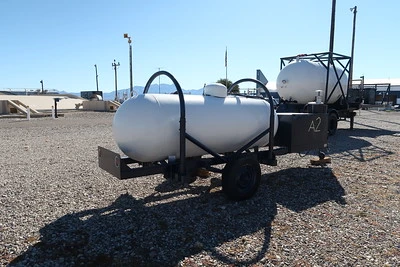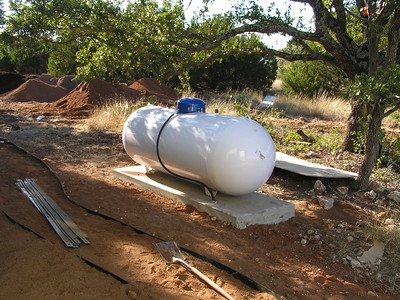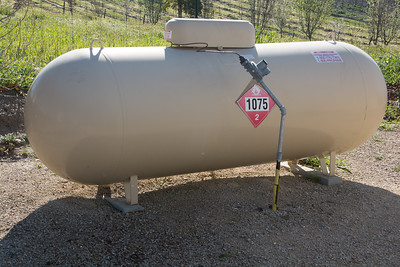
Yes, you can transport a 500-gallon propane tank, but it requires following specific safety and legal rules. You need a proper vehicle, like a flatbed truck, and must secure the tank upright. The tank should be mostly empty, and you must comply with DOT regulations, including placarding the vehicle. Professional help is often recommended due to the complexities involved
Transporting a 500-gallon propane tank involves strict regulations and safety precautions in the U.S. Here’s a simplified breakdown:
- Regulatory Compliance: The U.S. Department of Transportation (DOT) requires that vehicles transporting more than 1,000 pounds of propane or a propane tank of this size be placarded with specific hazard warnings. This is to ensure everyone knows the cargo is hazardous. Additionally, tanks transported for commercial purposes must comply with DOT regulations, which include proper securing, placarding, and using approved vehicles.
- Vehicle Requirements: A 500-gallon propane tank must be transported on a vehicle capable of handling its weight and size, typically a flatbed truck or trailer. The vehicle must be equipped with stabilizers, straps, or chains to secure the tank in an upright position to prevent movement during transit.
- Safety Precautions: Before transport, the tank should be emptied or have minimal propane content to reduce risk. Disconnect all fittings and hoses to prevent damage. The tank should be cleaned of any debris that might ignite. It’s also essential to inspect for leaks before and after transport.
- Loading and Unloading: Special equipment, such as cranes or forklifts, is needed to load and unload the tank safely. This equipment must be operated by trained professionals. During loading, the tank should be positioned in the center of the trailer to distribute the weight evenly.
- Local Regulations: In addition to federal rules, some states may have additional requirements, so it’s crucial to check local laws before transport.
Transporting such a large propane tank is not a task to be taken lightly and often requires professional assistance due to the complexities and risks involved
Do You Need Hazmat Placards to Transport It?
- Bulk Tank Classification:
- If the tank hasn’t been cleaned and purged, it still contains propane or residue. This is considered a “bulk tank” during transportation. Bulk tanks are subject to stricter regulations because they carry hazardous materials. The U.S. Department of Transportation (DOT) requires these tanks to be treated as hazardous material shipments, meaning you must follow specific guidelines.
- HAZMAT Placards:
- For unpurged tanks, you need HAZMAT placards on the vehicle. These are signs that indicate hazardous materials are being transported. Placards are required to ensure that emergency responders and others on the road are aware of the risks involved with transporting such a tank.
- Shipping Papers:
- In addition to placards, you’ll need shipping papers that outline the contents of the tank. These documents provide details about the propane, including quantity and safety information, and are essential for compliance with DOT regulations.
- Other HAZMAT Requirements:
- Besides placards and shipping papers, you must comply with additional HAZMAT regulations. This could include specific packaging, proper labeling, and following safe loading and unloading procedures. The aim is to minimize the risk of accidents during transport.
- Cleaned and Purged Tank:
- If the tank has been cleaned and purged (meaning all propane and residue have been removed), it is no longer considered hazardous. In this case, you don’t need to follow the HAZMAT regulations, including the need for placards and shipping papers. This makes the transportation process simpler and less regulated.
In summary, whether you need to comply with HAZMAT regulations depends on whether the tank still contains propane or has been fully cleaned and purged. If it’s not purged, you must follow the full set of HAZMAT requirements, but if it is, those rules no longer apply.
Legal Requirements for Transporting a 500-Gallon Propane Tank
1. General Regulations for Transporting Propane Tanks:
- The U.S. Department of Transportation (DOT) regulates the transportation of propane tanks, including large ones like a 500-gallon tank. These regulations are designed to ensure safety during transport.
- Propane tanks must be transported upright and securely fastened to prevent movement. The DOT also requires that tanks be in good condition, without leaks or visible damage.
- For tanks containing propane, specific HAZMAT (hazardous materials) regulations apply. This includes the need for placards on the vehicle if the total propane weight exceeds 1,000 pounds.
2. Special Rules for Large Tanks (500-Gallon Size):
- Transporting a 500-gallon tank falls under stricter guidelines because of its size and potential hazards. If the tank still contains propane, it is classified as a bulk tank, which triggers more extensive HAZMAT requirements.
- If the tank has not been emptied and purged of propane, you’ll need to display HAZMAT placards on the transporting vehicle. These placards warn others that the vehicle is carrying hazardous materials.
- Shipping papers, detailing the contents of the tank, must accompany the transport. These papers are required by law and provide important information in case of an emergency.
3. Permits and Special Licenses:
- Depending on the state and the specific nature of the transport, you may need special permits or licenses to legally move a 500-gallon propane tank. For example, if you’re transporting the tank across state lines or for commercial purposes, a HAZMAT endorsement on your driver’s license might be required.
- Additionally, commercial transport companies must comply with both federal and state regulations, which could include additional permits or inspections before transport.
4. Exceptions for Cleaned and Purged Tanks:
- If the 500-gallon tank has been cleaned and purged, meaning all propane and vapors have been removed, it is no longer considered hazardous. This removes the need for HAZMAT placards and shipping papers, simplifying the legal requirements.
Transporting a 500-gallon propane tank involves adhering to DOT regulations, especially if the tank still contains propane. This includes securing the tank, displaying proper placards, and having the necessary documentation. Depending on the situation, special permits or licenses may also be required
Suitable Vehicles for Transporting a 500-Gallon Propane Tank
1. Flatbed Trucks:
- Why They’re Suitable: Flatbed trucks are ideal for transporting a 500-gallon propane tank due to their open design, which makes loading and unloading easier. The open bed allows workers to use cranes or forklifts to lift the tank onto the truck without worrying about confined spaces. The flat surface of the truck bed provides a stable base for the tank during transport, minimizing the risk of tipping over.
- Safety Considerations: It’s crucial to secure the tank with heavy-duty straps, chains, or other securing devices. The tank must be kept upright, as laying it down could lead to dangerous situations, such as leaks or damage to the pressure relief valve.
2. Trailers:
- Why They’re Suitable: Heavy-duty trailers are another popular choice for transporting large propane tanks. These trailers can be attached to a truck, allowing you to move the tank over long distances. Their design accommodates the tank’s size and weight, providing a stable platform for safe transport.
- Safety Considerations: As with flatbed trucks, ensuring that the tank is properly secured on the trailer is vital. The trailer should also be checked for weight capacity to ensure it can handle the load. Overloading a trailer can lead to handling issues, tire blowouts, or even accidents.
3. Lowboy Trailers:
- Why They’re Suitable: Lowboy trailers have a lower deck height, which makes them useful for transporting tall or heavy equipment, including 500-gallon propane tanks. The lower height of the trailer reduces the overall height of the load, making it easier to comply with height restrictions on highways.
- Safety Considerations: Like with other vehicles, the propane tank must be securely fastened to prevent movement during transport. The lower height also helps with stability, but proper securing methods are still necessary to avoid any shifting during transit.
4. Enclosed Trailers (with Caution):
- Why They’re Suitable: Enclosed trailers provide protection from the elements, which might be necessary in certain situations. However, they are generally less suitable for large tanks like the 500-gallon size due to space constraints and the need for ventilation.
- Safety Considerations: If an enclosed trailer is used, it’s essential to ensure proper ventilation. Propane tanks need to be kept in a well-ventilated area to prevent gas buildup, which can be dangerous. Additionally, the tank still needs to be secured upright and fastened tightly.
Importance of Vehicle Capacity and Securing the Tank:
- Checking Vehicle Capacity: Ensuring that the vehicle can handle the weight of a 500-gallon propane tank is critical. Overloading a vehicle can lead to accidents or damage to the vehicle and tank. For example, a fully filled tank can weigh significantly more than 1,000 pounds, so the vehicle used must have the capacity to handle this load without straining the engine or suspension.
- Securing the Tank: Properly securing the tank is one of the most important steps in safe transport. The tank must be strapped down securely, ensuring it remains upright and stable throughout the journey. Loose or improperly secured tanks can shift during transport, which is extremely dangerous, especially with hazardous materials like propane. Double-checking the securing mechanisms before hitting the road is essential for safety.
In summary, choosing the right vehicle and ensuring that the propane tank is properly secured and transported in compliance with safety regulations is crucial to avoiding accidents and ensuring a smooth transport process.
Hiring a Professional vs. DIY Transport
1. Hiring a Professional Transport Service:
- Why It Might Be the Safer or Easier Choice: Transporting a 500-gallon propane tank is a complex and potentially hazardous task. Professional transport companies have the experience, equipment, and knowledge to handle such jobs safely and efficiently. They are familiar with all the necessary regulations, including securing the tank, obtaining permits, and using the correct vehicles. Professionals also carry insurance, which can protect you in case of accidents or damage during transport.
- When to Choose This Option: Hiring a professional is often the best choice when you are unfamiliar with the regulations, lack the necessary equipment, or need to transport the tank over long distances. It’s also advisable if the tank hasn’t been purged and still contains propane, as professionals can handle the additional HAZMAT requirements safely.
2. DIY Transport:
- Why You Might Consider DIY Transport: If you have experience transporting large items, access to the right equipment (like a flatbed truck or trailer), and a solid understanding of the regulations, DIY transport might be a cost-effective option. It can save you money on hiring fees, especially if the tank is empty and purged, which reduces the complexity of the transport.
- Costs and Benefits: The main benefit of DIY transport is cost savings, as you won’t have to pay for professional services. However, you will still need to factor in the cost of renting or using your own equipment, securing permits, and potentially hiring additional help for loading and unloading. The risks are higher, though—without the expertise of a professional, mistakes could lead to accidents, fines for regulatory non-compliance, or damage to the tank.
Comparison:
- Safety: Professionals are trained and equipped to handle the safety aspects of transporting hazardous materials like propane. DIY transport involves more risk, especially if you’re not fully familiar with the process.
- Cost: DIY can be cheaper upfront, but you may incur additional costs if things go wrong. Professional transport is more expensive but includes insurance and reduces the risk of costly mistakes.
- Convenience: Hiring professionals is more convenient, as they handle all aspects of the transport, from permits to loading. DIY requires you to manage every step, which can be time-consuming and stressful.
In conclusion, hiring a professional transport service is generally safer and more convenient, particularly for those unfamiliar with the regulations and complexities of transporting a large propane tank. DIY transport can be a viable option for those with the right experience and equipment, but it comes with higher risks and responsibilities.
To Conclude This
Yes, you can transport a 500-gallon propane tank, but it comes with specific rules and safety requirements. If the tank still contains propane, you must follow HAZMAT regulations, including using placards, securing the tank properly, and ensuring it’s transported on a suitable vehicle like a flatbed truck.
If the tank is empty and purged, the process is simpler and less regulated. Whether you handle the transport yourself or hire professionals, safety should always be the top priority to prevent accidents or hazards during the journey.

Mike is an experienced propane technician with over 15 years of professional experience in the field. He has dedicated his career to helping customers with their propane needs, from installation to maintenance and repair. Together with Jeremy, he co-founded this website to provide useful information and guidance to customers seeking reliable propane services.




